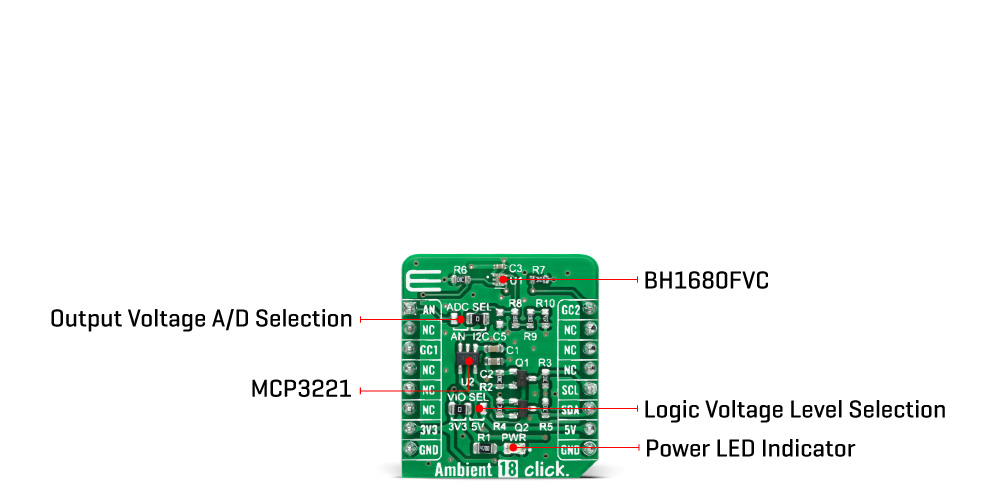50%
OFF
GO LOCAL
| Company | Stock | Price |
|---|---|---|

MIKROE-4943
18 g
Status:
Ambient 18 Click is a compact add-on board used to sense the amount of the present ambient light. This board features the BH1680FVC, an analog current-output ambient light sensor from Rohm Semiconductor. The BH1680FVC can detect a wide range of illuminance up to 10klx and provides excellent responsivity close to the human eyes' response. Besides, it is also characterized by low sensitivity variation across various light sources, a built-in shutdown function, and the ability to process the output signal in analog or digital form. This Click board™ is the most suitable for obtaining ambient light data for adjusting brightness in applications that require power saving and better visibility.
Ambient 18 Click is supported by a mikroSDK compliant library, which includes functions that simplify software development. This Click board™ comes as a fully tested product, ready to be used on a system equipped with the mikroBUS™ socket.
This product is no longer in stock
Availability date:
50%
OFF
| Company | Stock | Price |
|---|---|---|

Ambient 18 Click as its foundation uses the BH1680FVC, an analog current-output ambient light sensor from Rohm Semiconductor. It is composed of photodiodes, amplifiers, and current mirror circuits and can detect a wide range of illuminance up to 10klx, providing excellent responsivity close to the human eyes' response. It has stable performance over a wide temperature, voltage range, and a built-in shutdown function. It is characterized by good output linearity across a wide illumination range and low sensitivity variation across various light sources suitable to sense the amount of the present ambient light.

It also has four configurable modes of operation, shutdown mode associated with three gain modes: high-gain mode, medium-gain mode, and low-gain mode. The desired gain mode is selected through CS and PWM pins of the mikroBUS™ socket labeled as GC1 and GC2.
The output of the BH1680FVC can be converted to a digital value using MCP3221, a successive approximation A/D converter with a 12-bit resolution from Microchip, using a 2-wire I2C compatible interface, or can be sent directly to an analog pin of the mikroBUS™ socket labeled as AN. Selection can be performed by onboard SMD jumper labeled as ADC SEL to an appropriate position marked as AN and I2C.
The MCP3221 provides one single-ended input with low power consumption, a low maximum conversion current, and a Standby current of 250μA and 1μA, respectively. Data can be transferred at rates of up to 100kbit/s in the Standard and 400kbit/s in the Fast Mode. Also, maximum sample rates of 22.3kSPS with the MCP3221 are possible in a Continuous-Conversion Mode with a clock rate of 400kHz.
This Click board™ can operate with both 3.3V and 5V logic voltage levels selected via the VIO SEL jumper. This way, it is allowed for both 3.3V and 5V capable MCUs to use the communication lines properly. However, the Click board™ comes equipped with a library containing easy-to-use functions and an example code that can be used, as a reference, for further development.
Type
Optical
Applications
Can be used for obtaining ambient light data for adjusting brightness in applications that require power saving and better visibility
On-board modules
BH1680FVC - analog current-output ambient light sensor from Rohm Semiconductor
Key Features
Low power consumption, close responsivity to the human eye, good output linearity across wide illumination range, low sensitivity variation across various light sources, stable performance over temperature and voltage, possibility of signal processing in analog and digital form, and more
Interface
Analog,GPIO,I2C
Feature
No ClickID
Compatibility
mikroBUS™
Click board size
S (28.6 x 25.4 mm)
Input Voltage
3.3V or 5V
This table shows how the pinout on Ambient 18 Click corresponds to the pinout on the mikroBUS™ socket (the latter shown in the two middle columns).
| Label | Name | Default | Description |
|---|---|---|---|
| LD1 | PWR | - | Power LED Indicator |
| JP1 | VIO SEL | Left | Logic Level Voltage Selection 3V3/5V: Left position 3V3, Right position 5V |
| JP2 | ADC SEL | Right | Output Voltage A/D Selection AN/I2C: Left position AN, Right position I2C |
| Description | Min | Typ | Max | Unit |
|---|---|---|---|---|
| Supply Voltage | 3.3 | - | 5 | V |
| Maximum Output Current | - | - | 7.5 | mA |
| Peak Wavelenght | - | 530 | - | nm |
| Operating Temperature Range | -40 | +25 | +85 | °C |
We provide a library for the Ambient 18 Click as well as a demo application (example), developed using MikroElektronika compilers. The demo can run on all the main MikroElektronika development boards.
Package can be downloaded/installed directly from NECTO Studio Package Manager(recommended way), downloaded from our LibStock™ or found on Mikroe github account.
Library Description
This library contains API for Ambient 18 Click driver.
Key functions
ambient18_set_gain_mode This function sets the gain mode.
ambient18_read_voltage This function reads raw ADC value and converts it to proportional voltage level.
ambient18_voltage_to_lux This function calculates illuminance (lux) based on the voltage input.
Example Description
This example demonstrates the use of Ambient 18 Click board™ by measuring and displaying the illuminance value in Lux.
void application_task ( void )
{
float voltage = 0;
if ( AMBIENT18_OK == ambient18_read_voltage ( &ambient18, &voltage ) )
{
log_printf( &logger, " Illuminance : %ld Luxrnn", ambient18_voltage_to_lux( &ambient18, voltage ) );
Delay_ms( 1000 );
}
}
The full application code, and ready to use projects can be installed directly from NECTO Studio Package Manager(recommended way), downloaded from our LibStock™ or found on Mikroe github account.
Other Mikroe Libraries used in the example:
Additional notes and informations
Depending on the development board you are using, you may need USB UART click, USB UART 2 Click or RS232 Click to connect to your PC, for development systems with no UART to USB interface available on the board. UART terminal is available in all MikroElektronika compilers.
This Click board™ is supported with mikroSDK - MikroElektronika Software Development Kit. To ensure proper operation of mikroSDK compliant Click board™ demo applications, mikroSDK should be downloaded from the LibStock and installed for the compiler you are using.
For more information about mikroSDK, visit the official page.
NOTE: Please be advised that any peripheral devices or accessories shown connected to the Click board™ are not included in the package. Check their availability in our shop or in the YMAN section below.